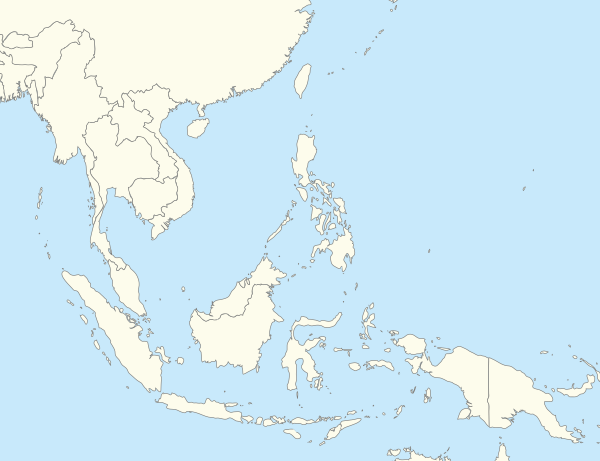 The biogeographical region of Malesia corresponds to Maritime Southeast Asia | |
| Geography | |
|---|---|
| Location | Indonesian Archipelago Philippine Archipelago Peninsular Malaysia East Malaysia Singapore |
| Total islands | 25,000 |
| Major islands | Borneo, Java, Luzon, Mindanao, Sulawesi, Sumatra |
| Area | 2,870,000 km2 (1,110,000 sq mi) [1] |
| Highest elevation | 4,095 m (13435 ft) |
| Highest point | Mount Kinabalu |
| Largest settlement | Bandar Seri Begawan |
| Largest settlement | Dili |
| Largest settlement | Jakarta |
| Largest settlement | Kuala Lumpur |
| Largest settlement | Quezon City |
| Largest settlement | Singapore |
| Demographics | |
| Population | 380 million [2] |
| Ethnic groups | Predominantly Austronesians, with minorities of Negritoes, Papuans, Melanesians, descendants of Chinese (including Peranakans), Arab descendants, Eurasians, Mestizos, Orang Asli and descendants of Overseas Indians and Sri Lankans |
Maritime Southeast Asia comprises the Southeast Asian countries of Brunei, Indonesia, Malaysia, the Philippines, Singapore, and East Timor. [3]
Contents
- Geography
- Biogeography
- Culture and demographics
- History
- Ancient Indian Ocean trade
- Maritime Silk Road
- See also
- Notes
- References
- External links
The terms Island Southeast Asia and Insular Southeast Asia are sometimes given the same meaning as Maritime Southeast Asia. [a] Other definitions restrict Island Southeast Asia to just the islands between mainland Southeast Asia and the continental shelf of Australia and New Guinea. There is some variability as to whether Taiwan is included in this. Peter Bellwood includes Taiwan in his definition, [5] [b] as did Robert Blust, [c] whilst there are examples that do not. [d]
The 16th-century term "East Indies" and the later 19th-century term "Malay Archipelago" are also used to refer to Maritime Southeast Asia.
In Indonesia, the Old Javanese term "Nusantara" is also used as a synonym for Maritime Southeast Asia. The term, however, is nationalistic and has shifting boundaries. It usually only encompasses Peninsular Malaysia, the Sunda Islands, Maluku, and often Western New Guinea and excludes the Philippines. [7]
Stretching for several thousand kilometres, the area features a very large number of islands and boasts some of the richest marine, flora and fauna biodiversity on Earth.
The main demographic difference that sets Maritime Southeast Asia apart from modern Mainland Southeast Asia is that its population predominantly belongs to Austronesian groups. The region contains some of the world's most highly urbanized areas—the Greater Manila Area, Greater Jakarta, Singapore, and Greater Kuala Lumpur—and yet a majority of islands in this vast region remain uninhabited by humans.



